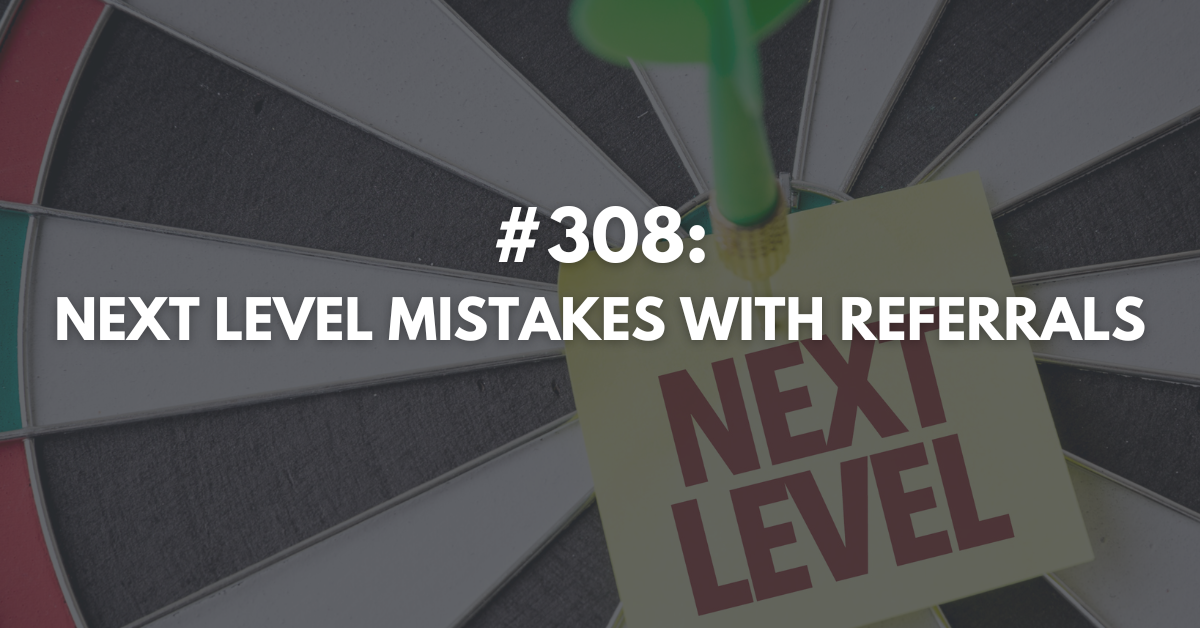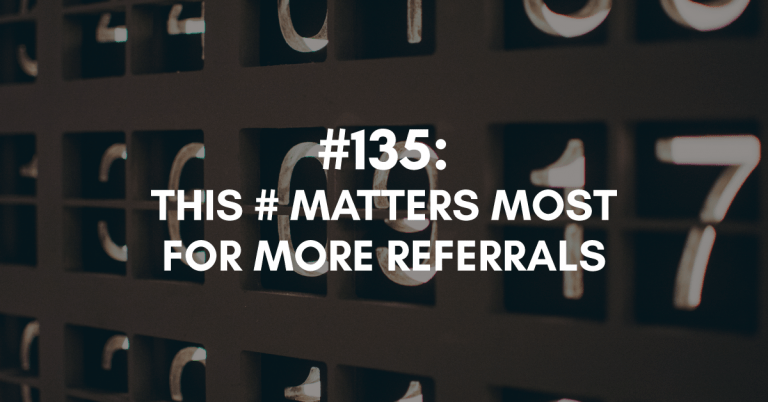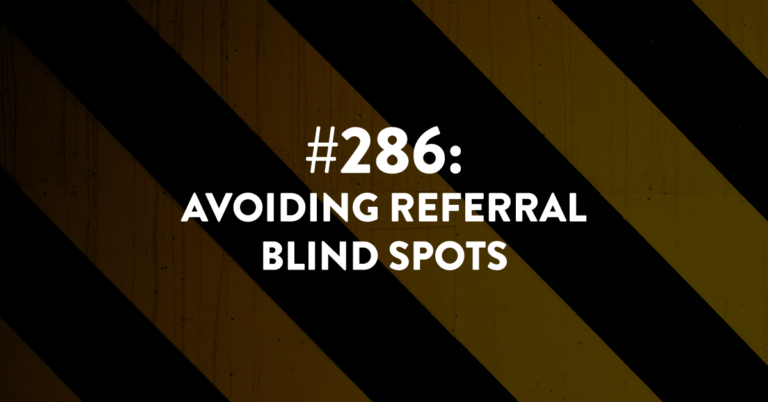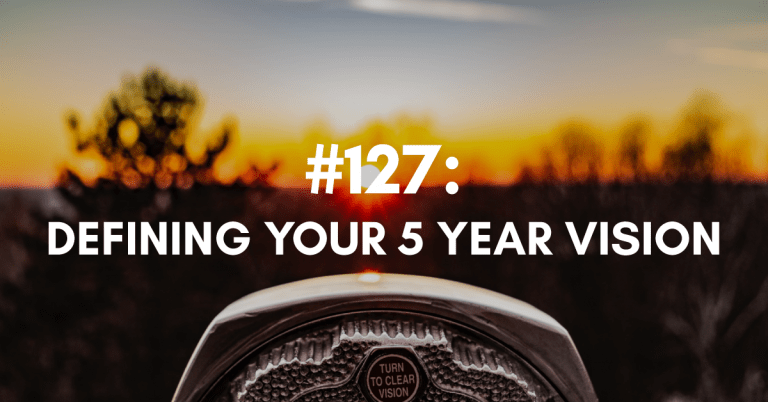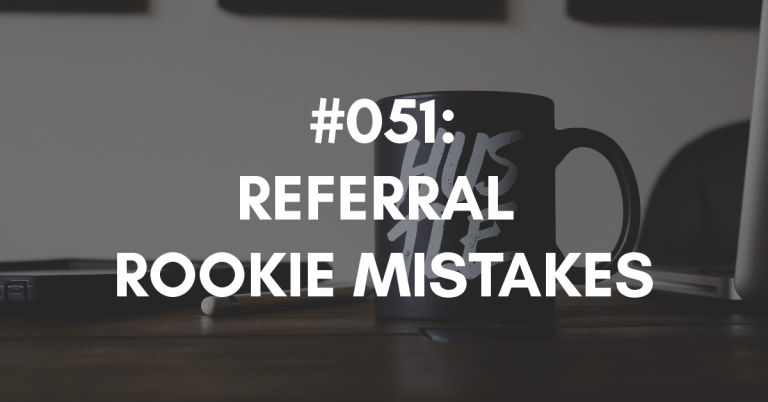Ep #308: Next Level Mistakes with Referrals
This episode dives into the advanced mistakes that people make in generating referrals after moving past rookie errors. Here are four next-level mistakes that can hinder referral success:
Using Existing Referral Plans for New Referral Sources: A common mistake is using the same strategy designed for nurturing existing referral sources to try and attract new referrers. It’s crucial to understand that these require different approaches; what works for current referrers might not be suitable for potential ones.
Addressing Quality and Closing Issues Incorrectly: Often, people receive referrals that aren’t the ideal fit or struggle with closing referred prospects. The key is not to “train” your referrers but to guide them gently and effectively to improve the quality of referrals without making them defensive.
Feeling the Need to Ask for Referrals: Even seasoned professionals struggle with the ingrained idea that they must ask for referrals. Trust the process and understand that referrals can be generated naturally without directly asking for them.
Making Emotional Decisions: In times of business slumps or personal challenges, it’s easy to make rash decisions about referral strategies. Staying consistent and making data-driven decisions is vital for long-term success.
Building a referable business is a journey, and avoiding these next-level mistakes is essential for long-term referral success. Keep taking control of your referrals and watch your business thrive!
Links Mentioned During the Episode:
Join me for my live training on May 15th and let’s calculate your referral reality together. To receive your invite, please submit your application.
Check out episode #302 for the top rookie referral mistakes I see many people make when trying to build a referable business.
Want me to build your Referral Strategy for you? Then check out my VIP Referrals In A Day service where I handle the heavy lifting for you. First step is to apply to see if you’re a fit and then we’ll schedule a call. (*A minimum of a 2-person team is required for this Done-For-You service.)
Next Episode:
Next episode is #309, which is another episode created with you and your needs in mind.
Download The Full Episode Transcript
Read the Transcript Below:
Stacey Brown Randall: In a previous episode, we discussed rookie mistakes made with referrals. In this episode, we’re going to dive into the next level of mistakes I see people making when they’re done making those rookie mistakes.
Hey there, and welcome to episode 308 of the Roadmap to Referrals podcast, a show about helping you build a referable business. I’m your host, Stacey Brown Randall. My journey from a business failure to a successful business now 10 years in, I know generating referrals naturally and consistently has made all the difference. Working with clients around the world, we leverage the science of referrals, protect relationships above all else, and help you build a referable business.
Before we dive in today’s episode, check this out. I want to calculate what should be possible for you with referrals this year, and then I want to show you exactly how to get to those results.
For me to do that, I need you to join me on May 15th for a live training. My ability to show you exactly how to unleash your referral explosion is really dependent on your business. So I need to understand it. And you need to join me for the training so we can do that together.
To join me for this training, I need you to complete an application by noon on May 14th, So if you’re listening to this and it’s well past that, that’s okay. I’m sure there’s a recording I can send to you.
Go to StaceyBrownRandall.com/referable for all the details and to submit your application. If accepted, you’ll receive all of the training details. And I’m doing something different with the training as I walk people through how to understand how to get to the goals you want with referrals, and then, of course, how we do that inside my coaching program.
With this training, I’m doing something a little different. I’m taking the training I typically do, which runs about 60 to 70 minutes, and I’m challenging myself to get it done, that training for you, in just over 30 minutes. So you should definitely join me on May 15th to see if I can accept and master my own challenge.
All right, I hope you will join me on May 15th for our live training. To do that, remember, go to StaceyBrownRandall.com/referable and submit your BRB application. Do it now, you have less than a week.
In episode 302, which we will link to in the show notes page for this episode, and the show notes page for this episode is StaceyBrownRandall.com/308. But in episode 302, I went over a few of the top rookie mistakes that I see people making when they’re trying to generate referrals.
So some of those rookie mistakes that I went over and covered were seeing referrals as just another sales activity. That’s a huge red flag for me that someone is operating with a rookie mindset if they think referrals is just another sales activity that they’re doing that’s a part of their marketing or a part of their prospecting.
Another rookie mistake is believing referrals just happen. Because they don’t. Nothing magically grows on any trees.
Another rookie mistake I see people making is actually how they think they’re supposed to take care of their referral sources, aka the humans that are referring them.
And then, of course, another rookie mistake I see people making is they really lack a plan that they can manage. Because if you can’t manage it, you can’t be consistent with it.
And so those are just a couple of the rookie mistakes that I see people making. And if you wanna hear all of the rookie mistakes and hear me go into in depth on what I mean with those rookie mistakes, head on over, just hit pause right now, head on over to episode 302 and listen to that episode and then come back and listen to this episode.
Because this episode is now all about the next level of mistakes that I see people making once they’ve graduated from making rookie mistakes. So for this episode, we’re going to assume you’re no longer a rookie when it comes to generating referrals, right?
Which means if you’re no longer a rookie when it comes to generating referrals, that you have had a mindset shift on where referrals come from and where they fit into your sales, or some people call it your business development strategy.
And if you’re no longer a rookie, it means you’re also in a place where you have a plan to care for your existing referral sources that you are committed to and execute on year in and year out.
But that’s not all. Of course, you know that. If you’ve been listening, if you’re a longtime listener to this podcast, you know that’s not even close to being all the things that you can get right in your business to generate more referrals than you ever thought possible.
So let’s dive in to what are these next level mistakes. Now, again, just like with the rookie mistakes that I did in episode 302, this isn’t all of them. There are lots of mistakes I see people making, but I wanted to pull out the big ones that I see people making consistently that I’m constantly course correcting with my clients.
Or people will hop into my DMs on LinkedIn, which you guys are all welcome to do at any time, but they’ll hop into my DMs on LinkedIn or on Instagram and they’ll ask a question, and I know it’s like, oh no, we’re just operating from the wrong mindset, or we have false information that we’ve been believing is truth, and we need to switch what you’re doing and what you think you’re supposed to be doing and the behaviors you take and the actions you take with referrals.
So again, this isn’t all of the next level mistakes, but it’s some good ones. So let’s dive in.
Here is one of the next-level mistakes I see people making. They think that their plan to take care of their existing referral sources can then also be used to cultivate new people to refer them.
Let me say that again. They think the plan that they create to take care of their existing referral sources, meaning the people who have referred them or are referring them, they think the plan they build for those people, their existing referral sources, can then just be used like copy paste. It can be used to cultivate new people to start referring them. And that is never the case.
So if you listen to the rookie mistakes episode I did, I talked about, people don’t know how to think about taking care of the people who are referring them. Because people who are already referring you, that is your low-hanging fruit. That is your quickest ability. It’s the way I work with my clients. It’s my quickest ability to get the most referrals as fast as we can.
Because those people have already done it. And we’re just trying to encourage and nurture and cultivate that continuation of a habit, that continuation of an action they’ve already taken. So that plan we build is very specific and based on the science that’s behind referrals because they’ve already referred you.
But that plan you build cannot be used for people who’ve never referred you. If you took the plan you use to cultivate more referrals from people who’ve already referred you in the past, and you were to apply it to new people who’ve really, quite frankly, maybe never even considered referring you, like the thought never crossed their mind, that’s like asking someone to marry you on the first or second date.
You’re not there yet. So you can’t apply the same plan from a group of existing referral sources to potential referral sources. You need to cultivate, really focus on building a relationship with these new people. These people that you want to start referring you, the ones that you want to become your, that you’re like, hey, you’re a potential referral source.
I mean, you don’t say this to them, right? But you’re thinking to yourself, hey, they would be a great referral source. I need to cultivate and focus on building a relationship with them, which means you better be willing to go slow, like dating.
You better be willing to go slow, and you better be willing to focus on them first, helping them, understanding them, cultivating a relationship with them, and not so worried on the fact that you’re hoping referrals come out of that relationship as well. You need to be paying attention to how you can help them.
And then, of course, what I teach my clients is, and then we also want to focus on how we plant referral seeds. But the language we use with someone who’s never referred you is not the same language we get to use with someone who has referred you.
So just because you’ve built out a plan to take care of your existing referral sources, your current referral sources, the people who are referring you right now, do not think you can carbon copy that over, copy paste that over to new people, potential referral sources, because it’s not going to work.
It’s going to fall flat, and you will not be successful. And you actually could damage some relationships in the process. So that is one of the next level mistakes that I see people making.
Okay, here’s another next level mistake that I see people making. Incorrectly addressing quality issues and closing issues. So what do I mean by that?
So incorrectly addressing quality issues is when what I mean by quality is that the referrals you’re receiving, they’re not the right fit for a client. They’re not your ideal client. It would be like an interior designer who does whole home renovations having somebody refer to them that just wants to freshen up their downstairs half bath. Not ideal, right? Not the kind of client that that designer is going to use, right?
Or not the type of client that that designer is going to say yes to when they do whole home renovations to do a half bath and just refresh it. So when I say quality, I mean who’s being referred to you, it’s not the right fit.
Either they don’t want to work with you the way you work with clients. They can’t afford you. They’re out of your niche. They don’t have the problem that you solve. Whatever. There’s lots of quality issues out there.
But what I see, though, is people incorrectly addressing that quality issue. Like, oh, you’re not referring me. Or you just didn’t refer me the right person, so now I need to fix this. And this is how this goes. And it’s terrible. So don’t do this.
It happens every time I’m talking to someone. And someone will say to me, I’m not getting the right kind of referrals. I’m not getting my ideal client. I’m not getting the right quality of prospective clients being referred to me, so I need to train those people how to refer to me, because they just don’t get it.
And I want to shake them. I’m going to be perfectly honest with you. There’s a part of me inside that just dies. I’m like, oh my gosh. When you use the word train, I need to train those people how to refer correctly to me. A little piece of me dies inside. And it should be dying in you, too, right now.
Because here’s the thing. Your referral sources, the people who are trying to refer to you, they’re not pets. They’re not dogs. They don’t need to be trained. Yes, they probably do need to be guided and they probably do need to understand who is an ideal client. But how you do that is paramount to whether or not they’re going to keep referring you or not. And there is an art to that language.
Now what I teach my clients, it’s four simple sentences. This is not a complicated art, but there is an art to how you have this conversation. And what I see people doing is they’re getting referrals, granted not the right quality, and they’re like, oh, I gotta tell you how to do it right. Don’t do that.
Nobody, here’s the thing. When people refer you, guess what they really want without telling you? They actually kinda want it to be their idea. They don’t want you telling them to do it, right? That’s the asking piece I’m always against.
And then if they’re doing it and they’re doing it wrong, they also don’t want you to make them defensive saying, hey, you’re doing this wrong. Let me train you up. I don’t know if you guys could just catch my little voice I did there, but don’t do that, right?
People don’t need to be trained. Yes, they need to understand, but they’re not dogs. They don’t need to be trained. They need to understand in a way that doesn’t make them defensive. So in that regards, they ultimately understand the right people to refer to you. And because you didn’t make them defensive, they actually keep referring to you, just trying to refer better quality.
The other thing is, is I’ll see people say, hey, that person just referred me, and I didn’t get the right potential client referred to me. Like the first time they ever referred to you. And they’re like, I got to fix this. They didn’t refer to me the right person. I’m like, stop. We don’t actually try to change the quality of who someone’s referring to us until there’s a pattern.
So I did an episode earlier this year. Yes, I should know the episode off the top of my head, and I don’t, my apologies. When we figure it out, we will put it in the show notes.
But I did an episode earlier this year, and I talked about how working with a real estate agent inside my coaching program, BRB, that there was a couple of people consistently referring, in her mind, there were a couple of people consistently referring non-quality, non-ideal clients.
And so I said, we don’t make any decisions, and we don’t do anything until we’ve run the numbers, and we’re looking at the data, and we actually understand. Turns out, a couple of the people that she thought were referring her poor quality was actually more 50/50.
Fifty percent of the time, they referred awesome, amazing clients. And the other 50% of the time, they didn’t. And so I said, do you want to try to change that? Because they are hitting it out of the park 50% of the time.
She was like, no, I don’t want to change anything. I want to take that 50% that’s good and know that I may also get some that aren’t some great quality. I’m like, great, because that’s called normal. But then it also did reveal that she did have one or two people that weren’t ever referring quality. And then we were able to dig in and address that.
So sometimes people are like, oh, you’re sending me bad quality. But if you look back, sometimes they’ve sent you good quality. And then every once in a while, they refer you someone you can’t help. Happens to me all the time.
I have somebody who joined my program just a couple of months ago, referred me someone. I was like, amazing fit. This is great. And then the next person they referred, not an amazing fit. right? And I know exactly how to have that conversation, right? And what that looks like.
But I never do it based on one single referral. You’re looking for a pattern of quality issues before you decide you’re going to dive in and do something about it. And the other thing I see people doing is like with closing issues.
And what I mean by closing issues is that I have my clients, and I hope you’re doing this, too, if you’re not a client of mine. I have my clients track not only the referrals they receive, but how often they’re closing them.
So we’re tracking not only, hey, you got 50 referrals last year, and you closed 39 of them. So we’re tracking how many referrals received and our closing ratio. What’s the percentage of the number of clients from those referred prospects that we’re closing into paying clients?
But then we go one layer deeper, and we just kind of look at it from the, okay, do you have any referral sources that you consistently close? And do you have any referral sources that you never close?
Well, sometimes when people are like, I receive referrals from this person all the time, they are my ideal client, but I’m never closing them. And then the initial reaction has got to be something about, I got to go train them, right? I got to go tell them why it’s their fault, I guess they’re thinking, right? That I’m not closing the people that they’re referring to me.
And so when I see people use that kind of language, I know I’m like, oh no, this is a mistake you’re making, and you need to know how to solve that correctly.
So when you have closing issues of the clients you are receiving that are ideal and you want to close them and you’re not, we got to dig into what that’s happening there. And then when you’re receiving poor quality referrals, we got to dig into what’s happening there.
But most of the time, what I find when people are making a next level mistake when they’re getting referrals, and they’re not the right quality, and they’re not closing them, is that they incorrectly decide how they’re going to address it. And we don’t want to do that.
Okay, so that’s two of the next level mistakes that I see people make. And we’ve got two more coming up. But hey, hang on, we got to do the part in the interruption.
Stacey Brown Randall: Hey there, pardon the interruption. Ever wondered how a current member of my Building a Referable Business Coaching program would describe their experience? Well, I wanted to know, so I asked them. And here’s what they had to say.
Client: If I had to describe BRB in one word, it would be transformative. It really changes the way that you look at your interactions with the people who can provide business for you.
Client: I would define BRB in one word as a community. It’s always a positive experience. She’s extremely, well, she’s very organized. She makes everything seem easy, even when it’s not actually easy. And she’s extremely motivating.
Client: Defining BRB in one word would be relationships.
Client: BRB, in one word, effective. If you’re looking for an effective program, BRB is it. If you’re looking for a great, knowledgeable expert and cheerleader, then Stacey’s definitely the person to work with.
Client: If I could define BRB in one word, it would be elevate, because it’s certainly elevated my business.
Client: BRB means progress to me. What I would say to someone, the reason to join BRB, is if you’re in a business that’s a referral business, and that’s the most important piece of your business, then I can’t think of a better way to invest in it than invested it in the best authority when it comes to referral business. Stacey.
Stacey Brown Randall: If you want to join us inside the coaching program, Building a Referable Business, or BRB for short, I would love to have you join me. And if you’re listening to this episode around the time that it went live, you can actually join me for a free live training that I’m doing on May 15th, where I will walk you through exactly how I get my clients the types of transformation they just shared with you and to how they describe the BRB coaching program.
So to apply for BRB and get your invite to the May 15th, training, please go to StaceyBrownRandall.com/referable. When you go to that link, you’ll be able to learn all about the program and then of course submit your application. And keep in mind, even though you submit an application and maybe you’re going to attend my live training on May 15th, you’re under no obligation to say yes to working with me.
This is your opportunity to see behind the curtain of how I make it happen and then decide, is it the right thing for you. Maybe, maybe not. Why don’t you come to my training on May 15th, and you’ll be able to figure that out for yourself. All right, now back to the episode.
Stacey Brown Randall: Okay, so here’s the next, next level mistake that I see people making. Thinking you still have to ask or figure out how to make that asking fit within your overall strategy. It’s so true. I have people who don’t want to ask. They do it because they’ve been told they have to.
They read my book. They listen to this podcast. Maybe they become a client of mine, and they are totally on board with the without asking. But there is still this itty-bitty, tiny voice in the back of their head that says, “OK, you’re doing all this stuff now. You’re at this point. Now you have to ask.”
And it really is a battle for them to let go of it, because it’s been beaten in their poor heads for decades. The longer you’ve been in business, the longer this one has probably been beaten into your poor head, right?
Look, I get it. This is a hard one to let go of. This idea that you can do all these things and then you, of course, need to trust the process to be able to generate referrals without asking and without manipulation and without incentivizing to do all those things.
And then you have this decade long advice chirping in the back of your head. But at some point, you have to still ask. At some point you still have to ask. Absolutely. No, you do not. And it is a hard one to let go of because it has been beaten into people’s heads.
And so when I’m working with people and I see them come in with that, it is typically someone who has been in business longer than not. So this is not someone who’s been in business like one or two years. It’s usually someone who’s going to be in business closing in on double digits, awfully close to double digits if you’re in business.
And they are totally on board with the generating the referrals without having to ask, without having to manipulate, without having to be promotion gimmicky, without having to incentivize. They’re totally on board with that.
And they are implementing what I teach. And most of the time, they’re seeing success. They’re like, oh my gosh, it’s happening. And then yet, they are still battling this little, tiny piece that will somewhere in there, somewhere in that email sequence we’re sending out, or somewhere in our newsletter, or somewhere in that client experience process, I still have to ask them to refer me.
And the answer is no, you don’t. And when you make that decision to do that, you’re making a mistake. And it will negatively impact your future referrals. And it will actually hurt everything you’re doing with me. So it’s a hard one, I get it, but you gotta let go of it.
Okay, and here’s our final next level mistake that I see people making. And this one may, this one may hit ya. This one may get ya right in the gut when I say it. And some of you, this may not be relevant for you, but some of you, this is one that you’re probably hiding. And here it is.
Another mistake I see people making, and I usually see it when people are having success with referrals, which is great, and then other things change in their business. But they make emotional decisions on the actions they need to be taking to generate referrals.
So they will make very emotional, which is most of the time irrational decisions, on what they need to be doing, what they know they should be doing, to really generate referrals. Now, how does this play out?
So sometimes I see this when people hit a slump. And maybe it’s a slump in the referrals that they’re receiving, or maybe it’s a slump in the referrals they’re receiving that they’re then able to close into clients. Or maybe it’s a slump because they stopped getting feedback from some of the people that are their referral sources and that are receiving their ongoing touch points that we’ve created together.
So sometimes the referral piece just hits a slump. Sometimes it has absolutely nothing to do with referrals, and something else in their business hits a slump. And instead of making a data-driven decision, and instead of making a decision based on the fact that knowing every business goes through cycles, and instead of making a decision based on knowing that, yes, sometimes you are getting more referrals than you can handle, and it could be the next couple of weeks, maybe it’ll be a little bit quieter, and that’s totally normal.
Instead of making rational decisions on continuing the course, staying consistent, I see them make emotional rash decisions where they kind of put their hands up and they’re like, ah, it’s not working. I’m out. Ah, stop doing things. I’m not getting the feedback I need. Ah, stop doing things. This isn’t working because I got referrals for a whole bunch of quarters in a row and now, I haven’t gotten any for three weeks.
That’s irrational. That’s emotional. You will have highs and lows. There are moments in my business, yes, even me, I will go through a week or longer, definitely sometimes longer, where I don’t get a referral. And it’s about the minute I start to be like, oh, what’s going on, that I’m like, I can’t control the day they’re going to drop into my lap.
You can’t. I can’t. Nobody can. And if someone tells you they can control the day the referral is going to show up, run away as fast as you can, because they are selling snake oil or something that is not referrals or just calling it referrals because they’re going to bait and switch you and they’re trying to get your attention.
So here’s the thing. We don’t control when those referrals show up. This is a long-term play, and we understand that. We’re playing the long game here. And we also understand we’re talking about humans that are not out there thinking about referring you every day. They’re thinking about running their own business and living their own lives.
And we’re doing the things to cultivate that relationship so that when there is an opportunity, they will refer us. But we don’t know exactly when or how often they’re going to come across those referral opportunities. So we stay consistent. And that is how I see clients do steady growth.
Even when they get a bunch of referrals that they can’t handle, they keep the actions going behind the scenes. And even when they go maybe a couple of weeks or even maybe a month or two without getting any referrals, they keep the actions going behind the scenes.
They do not move off course. They do not make emotional decisions of what they will continue or not continue in their business because of they’re in an emotional place. And sometimes I see people in an emotional place because of life. It has nothing to do with their business, but because of life.
But that emotional that they’re feeling in their personal life trickles in to the irrational and very rash decisions that they make in their business. And you can only really see it, I think, if you know the business and the business owner. And that’s my personal opinion.
Because if not, you’re just like, if you don’t understand maybe what they’re going through or why something’s happening, you may not be able to recognize this or pick up on the nuances of this. But I see it, right? I see it.
I’ve been doing this for 10 years. I’ve been working with clients for 10 years. I’ve had the pleasure to work with so many business owners. And over those 10 years, I have seen it. I have seen people, and I can’t always see it coming, but I am able to see it once it’s happened.
And I’m like, oh, right. They went through that really tough time. They threw their hands up. And they started looking for things that they could make some drastic actions to because it put them back in control, even though they were the wrong actions for them to take because something else was out of control in their business.
Or something didn’t go according to plan, they get so wrapped up in the outcome, and something didn’t go according to plan, they just abandon everything else that they’re supposed to do after that. And that will always negatively impact your long-term growth.
When I see people fall off the wagon, and they are supposed to do, I don’t know, let’s just say for sake of argument, five or six touch points in a year for their existing referral sources, and they fall off the wagon for four or five months, and then they come back to me and they’re like, hey, I need some help getting back on the wagon.
I’m like, absolutely, but I need you to recognize the slowdown you caused, and that’s gonna impact what’s coming in. So you can’t expect referrals to start flowing in over the next four or five months because you get back on the wagon. Like you don’t have to overcome the five or six months you just ignored everybody. Like we gotta recognize this for what it is.
And when I see people making those emotional decisions on the actions that they know they need to be taking to generate referrals, and they decide to stop them for a lot of emotional different reasons, or they decide to do something different, that is definitely a next-level mistake.
And it’s a hard one. It’s a hard one to overcome. It’s also a hard one to coach around because then you kind of feel like you got to tell somebody, you’re being emotional and let’s be honest nobody really ever wants to be told that. I certainly don’t enjoy telling that to people.
Nobody responds well when you’re like, you’re making an emotional decision you’re being emotional, right? That’s not a positive piece of feedback to receive. But that is, it’s another next level, probably like a higher, higher next level mistake that I see people making.
But I see people making it for lots of different reasons. Letting the emotions and not the data and not the consistency and not trusting the process work the way it’s supposed to. And then making very rash and irrational decisions that will negatively impact their business moving forward. And in this case, what I see impact their referral generation.
Okay, so that’s it. Those are the four next level mistakes that I see people making after they’ve graduated from making rookie mistakes.
So this is why I work with people inside my coaching program or my VIP program so that I can be with you for a whole year and we can work through these things and we can see around, I can see around the corners that you can’t see around yet and I can guide you.
This is why I love to work with people in that kind of one-on-one group format in my coaching program, but also my VIP one-on-one format as well. And it’s why everything I do right now, it’s a year. Like we are together. I am in the trenches with you, my friend.
Because once you graduate from Rookie Mistakes, I know you gotta be on the lookout for these next level mistakes.
Alright, the show notes page for this episode can be found at StaceyBrownRandall.com/308, which is where you’ll find a link to all the resources mentioned in this episode, including the link to go complete your BRB application so you can join me on May 15th for our live training.
We’re back with another great episode next week created with you and your needs in mind. Until then, you know what to do, my friend. Take control of your referrals and build a referable business. Bye for now.

